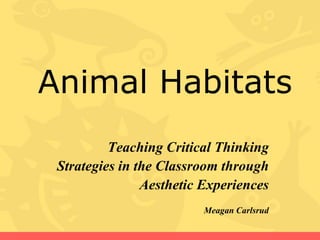
Animal habitats presentation
- 1. Animal Habitats Teaching Critical Thinking Strategies in the Classroom through Aesthetic Experiences Meagan Carlsrud
- 2. Objectives o Students will discuss the different habitats and the different animals we would see in each habitat. o Students will observe and discuss habitats using art images in a small group. o Students will create their own drawing of the animal and habitat that they chose. o Students will write a sentence or two describing the specific animal and habitat in their drawing. o Students will construct a digital story representing what was learned.
- 3. Day 1: Introduce the vocabulary word “habitat” along with the four main animal habitats (grassland, forest, desert, and tundra). We will read the story Animal Habitats by Michelle Kramer.
- 4. Day 2: As a class we will explore the National Geographic website online. We will look at photography of the different habitats, animals that live in those habitats and view videos of animals in their specific habitat. http://www.nationalgeographic.com Students will observe and discuss habitats in a small group using images from my art collection. http://www.artsconnected.org/resource/122219/teaching-animal-habitats- through-visual-art-by-meagan-carlsrud
- 5. Day 3: Students will independently choose an animal of their choice and match it up with one of the four images of major animal habitats observed. Students will create their own drawing of the animal and habitat that they chose. A writing sample will accompany the students’ artwork containing a sentence or two describing the specific animal and habitat in their drawing.
- 6. Day 4: Read the book Walking Through the Jungle by Debbie Harter View the YouTube video Walking Through the… Using the students’ final project, the class will construct a digital story representing what was learned by following the book and video example. http://www.youtube.com/watch?v=HTjdlSdxNjs
- 7. Assessment Rubric Topic 2 Novice 1 Partially Proficient 3 Total Proficient 2 Participated in class discussions Created a drawing of their animal and animal habitat Demonstrated early kindergarten writing skills Took part in creating a class digital story
- 8. Resources Amiegamache. (January 16, 2008). Walking Through the…Retrieved August 5, 2010, from YouTube. http://www.youtube.com/watch?v=HTjdlSdxNjs Harter, Debbie. (1997). Walking Through the Jungle. Orchard Books, NY. Kramer, Michelle. (2006). Animal habitats. National Geographic School Publishing. Minnesota Institute of Art. Teaching Animal Habitats Through Visual Art by Meagan Carlsrud. Retrieved on July 26, 2010. http://www.artsconnected.org/resource/122219/teaching-animal- habitats-through-visual-art-by-meagan-carlsrud National Geographic. (1996-2009). Retrieved August 5, 2010, from http://www.nationalgeographic.com/
- 9. Reflection This unit provides kindergarten students with multiple opportunities that combine vocabulary instruction, reading, and science with arts. The manner in which this lesson has been designed not only meets kindergarten standards, but also provides students with engaging learning activities.